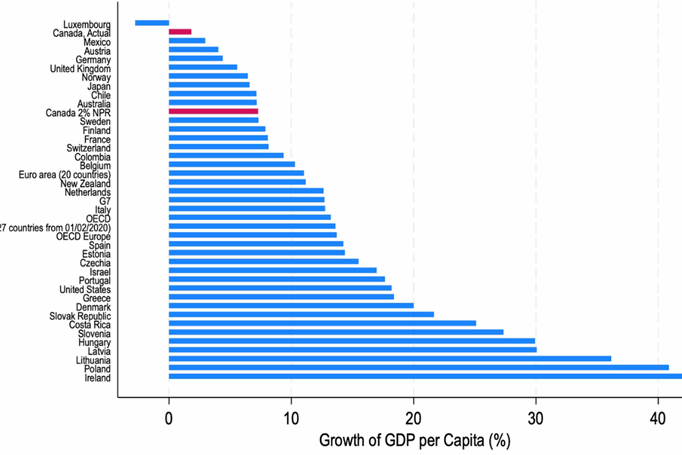By Michael Ras, Employee Ownership Canada and Jon Shell | Part of our Always Canada. Never 51 series. | This post first appeared in The Calgary Herald
In 2024, about 400 companies in the U.K. were sold to their workers using a structure called an Employee Ownership Trust (EOT). That represented about eight per cent of all private company sales in the U.K. Instead of being sold to outside investors or closed, those companies remain domestically owned, keeping jobs in communities and flowing future profits to workers.
As the threat to Canada’s sovereignty intensifies, we need policies that keep Canadian companies owned by Canadians. With many business owners approaching retirement and the Canadian dollar in free fall, Canada faces the risk of a significant sell-off of companies to Americans. Strong employee ownership policies can counter this, with little or no ongoing government intervention, by presenting an attractive alternative to owners looking to sell.
Currently, there are very few employee-owned companies in Canada, due largely to tax and trust laws that have made these kinds of transactions difficult. In June of last year, the federal government started addressing this by introducing an EOT structure and incentives encouraging uptake. The goal is to capture the same proven, positive outcomes seen for employees, business owners and the broader community since the U.K. introduced EOTs in 2014.
However, Canada’s policy is tentative compared to the U.K.’s. Our legislated $10-million capital gains tax exemption is set to expire by the end of 2026, far too soon given the lead time required in a business sale. It also includes several “red tape” provisions that have made it difficult or impossible for some business owners to access.
It’s a typically Canadian “let’s see how it goes” approach, but the time for that kind of dithering is over.
Friesens, a large Manitoba-based publisher and one of Canada’s few employee-owned companies, is currently showing the resilience of the model. They face major headwinds as they export the majority of their books to the U.S., but their CEO recently said, “You’re going to hear about job cuts and factory closures, but not at Friesens. Our objective is to keep our employee-owners as financially whole as we can for as long as we can.”
It’s hard to imagine a U.S.-based owner making a similar commitment.
Employee ownership also has a strong track record in the U.S., where a different version of the EOT (called an Employee Stock Ownership Plan) launched in 1974. Almost 15 million Americans now have share accounts in about 6,500 employee-owned companies, with an average value of about US$120,000. Along with these extraordinary wealth outcomes, these firms are proven to be more resilient in recessions, be more productive, grow faster and keep jobs in local communities. Early data on the U.K.’s EOT shows similar results.
Appealing to Canada’s workers is a clear priority for the Liberals and Conservatives. In the English language Liberal leadership debate, Mark Carney suggested that he would make it a “great time to be a worker in Canada.”
In a January video, Pierre Poilievre said that “instead of turning workers against business owners, we’ll turn workers into business owners.”
Both parties can demonstrate their support for Canada’s workers with platform commitments to extend and increase the EOT tax incentives and to remove unnecessary red tape. On the stump, employee ownership provides a rare opportunity to offer a message of hope that workers and communities can survive and thrive amid economic turmoil.
“We’ll help make you owners” is a hell of a rallying cry.
With Canada’s sovereignty at stake, we must invest in every approach to keeping Canadian businesses in Canadian hands. Simply matching the U.K.’s EOT success would see 300 Canadian companies sold to their workers each year; very few policies promise as powerful an outcome.
Employee ownership was a great idea in 2024. It has become an essential idea for Canada in 2025.
Share with a friend
Related reading
Blame the denominator, not the economy
Over the last couple of years, there have been countless articles warning of Canada’s poor economic performance. The mic drop has increasingly been Canada’s poor performance relative to peer countries on “GDP per capita,” with growth rankings used to draw a variety of sweeping, negative conclusions about Canada’s economy. SCP CEO Matthew Mendelsohn and Policy Director Dan Skilleter draw on economist and SCP Fellow Dr. Gillian Petit's new research to explain why GDP per capita is a deeply flawed measurement for evaluating rich countries - and is easily influenced by a variety of factors having little to do with economic performance or economic well-being.
Non-Permanent Residents and their impact on GDP per capita | Summary
New research by economist and SCP Fellow Gillian Petit estimates what Canada’s GDP per capita would have been over the past decade if Canada had kept our temporary resident numbers stable. She also estimates the expected impact on GDP per capita in the coming years due strictly to planned reductions in Canada's intake of non-permanent residents. Among key findings: Canada’s GDP per capita is misleading and should not be used as if it were the sole indicator of economic well-being. Plus, if we had maintained our temporary resident numbers at two percent of the population in recent years, Canada’s GDP per capita would look much more like our peer countries: a little bit ahead of countries like Germany, the United Kingdom and Australia and a little bit lower than countries like Belgium, Sweden and France.
Non-Permanent Residents and their impact on GDP per capita | Report
New research by economist and SCP Fellow Gillian Petit estimates what Canada’s GDP per capita would have been over the past decade if Canada had kept our temporary resident numbers stable. She also estimates the expected impact on GDP per capita in the coming years due strictly to planned reductions in Canada's intake of non-permanent residents. Among key findings: Canada’s GDP per capita is misleading and should not be used as if it were the sole indicator of economic well-being. Plus, if we had maintained our temporary resident numbers at two percent of the population in recent years, Canada’s GDP per capita would look much more like our peer countries: a little bit ahead of countries like Germany, the United Kingdom and Australia and a little bit lower than countries like Belgium, Sweden and France.

